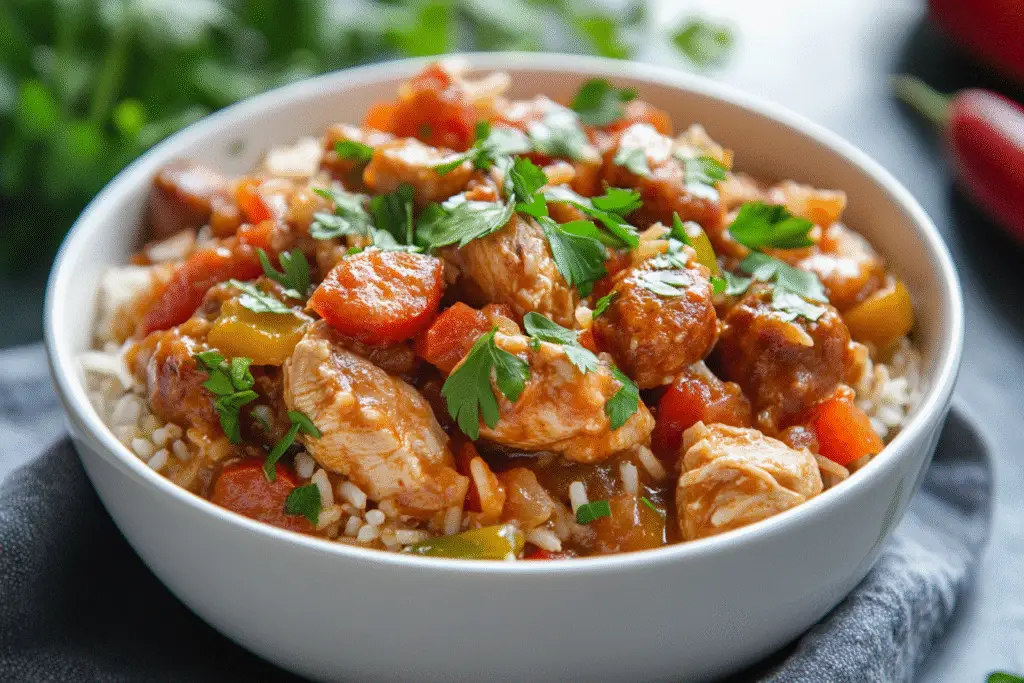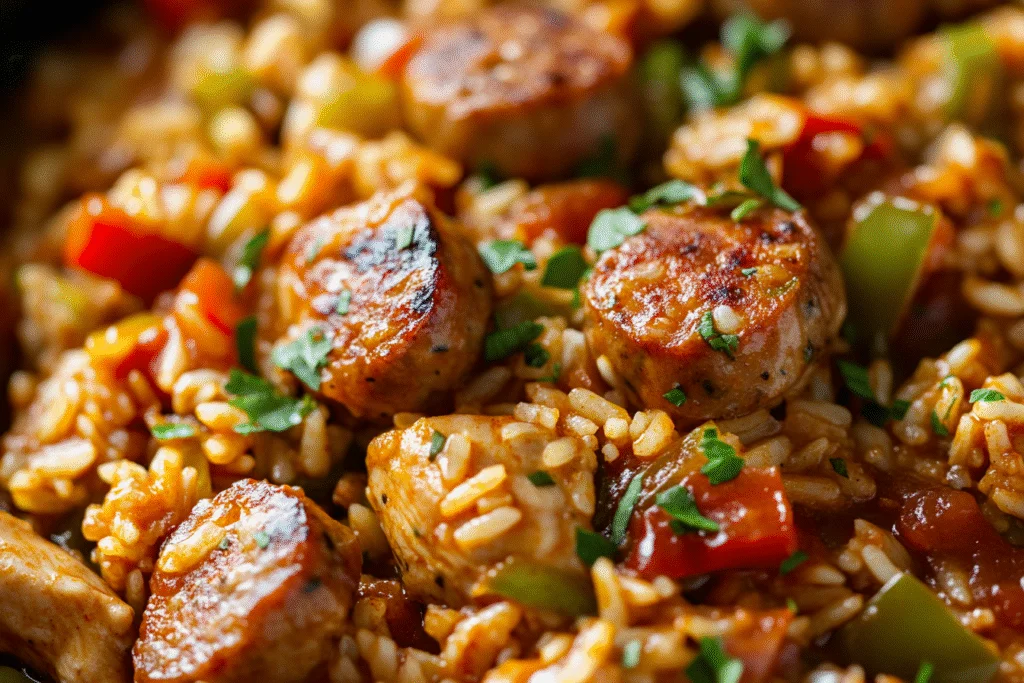If you’re craving a dish that’s hearty, flavorful, and guaranteed to wake up your taste buds, Slow Cooker Chicken Jambalaya is your ticket to a soulful, satisfying meal—without the stovetop fuss. This Louisiana classic is packed with bold Cajun spices, tender chicken, juicy sausage, sweet peppers, and rice that soaks up every ounce of flavor. Traditionally made on the stovetop, this slow cooker version makes it weeknight-accessible and nearly foolproof.
Think of it as a one-pot comfort food with a fiery kick—perfect for a cozy dinner, game day feast, or feeding a hungry crowd. It’s everything you love about jambalaya, just easier.
Jambalaya Basics: Understanding the Components
Jambalaya is a Creole and Cajun dish with deep roots in Southern cuisine. At its core, it’s a rice-based meal featuring a blend of protein (often chicken, sausage, and shrimp), aromatics, and a bold spice profile. There are two main types:
- Creole jambalaya (red) includes tomatoes and leans saucy
- Cajun jambalaya (brown) is made without tomatoes and has a more toasty, earthy base
This slow cooker version leans Creole, with tomatoes adding color and depth to the final dish. It’s made with chicken and smoked sausage for bold, meaty flavor, and rice stirred in near the end for perfect texture.

Chicken, Sausage, or Both? Picking the Right Proteins
Classic jambalaya includes more than one meat, and this version stays true to tradition with boneless, skinless chicken thighs and smoked andouille sausage. Here’s why each is important:
- Chicken thighs: Juicy and flavorful, they hold up to long cooking and shred beautifully.
- Andouille sausage: Adds smoky heat and that signature jambalaya punch. Kielbasa is a good mild substitute if you want less spice.
Want to add shrimp? No problem—stir in raw, peeled shrimp during the last 30 minutes of cooking to keep them from getting rubbery.
How to Keep the Rice from Getting Mushy
This is the #1 challenge with slow cooker jambalaya. To avoid mushy rice, follow this rule: don’t cook the rice the whole time. Instead:
- Cook the chicken, sausage, and sauce base for most of the time
- Stir in uncooked long-grain white rice during the last 30–45 minutes
This lets the rice absorb flavor while still keeping its texture. If you’re using brown rice, you’ll need to add it closer to the 90-minute mark before finishing, since it takes longer to cook.
If you’re meal prepping, consider cooking the rice separately and ladling the jambalaya over it instead.

Flavor Foundations: The “Holy Trinity” of Cajun Cooking
Every good jambalaya starts with the Cajun holy trinity: onion, bell pepper, and celery. In this recipe:
- Onions and bell peppers are used for sweetness and depth
- Celery is optional (since not everyone loves it), but adds traditional balance
- Garlic, tomatoes, and bold seasonings round out the flavor
Don’t skip the seasonings. This is where the magic happens.
Homemade Cajun Seasoning or Store-Bought?
Store-bought Cajun or Creole blends work in a pinch, but if you’ve got a spice rack, making your own takes 2 minutes and gives you more control.
Homemade Cajun Seasoning:
- 1 tablespoon paprika
- 1 teaspoon garlic powder
- 1 teaspoon onion powder
- 1 teaspoon dried oregano
- 1/2 teaspoon cayenne pepper
- 1/2 teaspoon black pepper
- 1/2 teaspoon salt
- 1/4 teaspoon thyme
Mix and use 1–2 tablespoons, depending on your heat preference.
Ingredients
For the Jambalaya Base
- 1.5 pounds boneless, skinless chicken thighs, cut into chunks
- 12 ounces smoked andouille sausage, sliced
- 1 (14.5-ounce) can diced tomatoes with juice
- 1 cup chopped onion (about 1 medium)
- 1 cup chopped green or red bell pepper
- 2 cloves garlic, minced
- 1/2 cup chopped celery (optional)
- 2 cups low-sodium chicken broth
- 1–2 tablespoons Cajun or Creole seasoning (store-bought or homemade)
- 1/2 teaspoon salt (adjust to taste)
- 1/4 teaspoon black pepper
- 1 teaspoon hot sauce (optional)
For the Rice
- 1 cup uncooked long-grain white rice (or jasmine rice)
- 1/4 cup fresh chopped parsley (for garnish)
- Optional: 1/2 pound raw shrimp, peeled and deveined
Instructions
- Assemble the Base
Add chicken, sausage, tomatoes (with juice), onion, bell pepper, garlic, celery (if using), chicken broth, Cajun seasoning, salt, pepper, and hot sauce (if using) to the slow cooker. Stir to combine. - Cook Low and Slow
Cover and cook on low for 5–6 hours or high for 2.5–3.5 hours, until the chicken is tender and cooked through. - Add Rice and Optional Shrimp
About 30–45 minutes before serving, stir in the uncooked rice and raw shrimp (if using). Make sure rice is submerged in the liquid. Re-cover and cook on high until rice is tender and has absorbed most of the liquid. - Shred Chicken and Stir
Once rice is done, shred the chicken using two forks (or leave in chunks if preferred). Stir everything to combine well. - Finish and Serve
Taste and adjust seasoning if needed. Serve hot, garnished with fresh parsley or sliced green onions. Add extra hot sauce if you like it spicy.
Storage and Reheating
- Refrigerate: Store in an airtight container for up to 4 days.
- Freeze: Freeze cooled jambalaya in freezer-safe containers for up to 3 months.
- Reheat: Warm gently on the stovetop or in the microwave. Add a splash of broth or water if the rice has absorbed too much liquid.
Serving Suggestions
- Crusty bread or garlic toast
- Simple green salad with citrus vinaigrette
- Fried okra or collard greens
- Cornbread muffins for a Southern-style side
Make it a full Southern meal with iced tea or a cold beer.
Variations and Comparisons
- Versus Gumbo: Jambalaya is rice-based and doesn’t use a roux; gumbo is brothier and often served over rice, not with rice cooked in.
- Versus Étouffée: Étouffée is smoother and more stew-like, typically made with a roux and served over rice.
- Versus Paella: While similar in concept (rice, meat, seafood), paella uses saffron and Mediterranean flavors. Jambalaya is spicier and more rustic.
With its rich spices, tender meats, and vibrant veggies, Slow Cooker Chicken Jambalaya brings Louisiana flavor home with almost no effort. It’s bold, filling, and perfect for any night of the week—proof that comfort food doesn’t have to be complicated.
